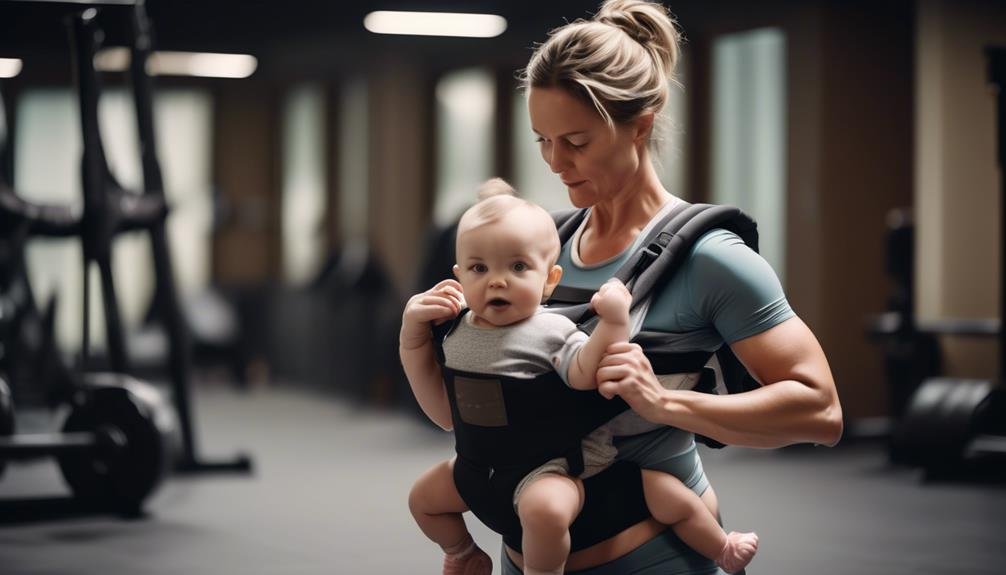"Cherishing Little Steps - A Haven for Baby and Family Journeys"
Safe Postpartum Weight Training
Are you a new mom looking to regain your strength and fitness after giving birth? If so, you've come to the right place.
Postpartum weight training is not only safe but also highly beneficial for your overall well-being. But before you grab those dumbbells, there are a few things you need to know.
In this discussion, we will explore the benefits of postpartum weight training, how to choose the right equipment, and how to properly prepare your body for this rewarding journey.
So, if you're ready to take the first step towards reclaiming your strength, let's dive in.
Key Takeaways
- Obtain clearance from a healthcare provider before starting any postpartum weight training program.
- Start with low-impact exercises and gradually increase intensity to prevent injuries.
- Incorporate a variety of exercises to target different muscle groups and prevent boredom.
- Listen to your body, modify exercises as needed, and prioritize rest and recovery for postpartum healing.
Benefits of Postpartum Weight Training

Are you ready to discover the empowering benefits of postpartum weight training? Congratulations on your journey into motherhood! Now, it's time to focus on your own well-being and regain the strength you once had.
Postpartum fitness isn't just about losing weight, but also about rebuilding your strength, both physical and mental.
Weight training is a fantastic way to achieve these goals. By incorporating weights into your exercise routine, you can build lean muscle mass and increase your overall strength. Not only will this help you feel more confident in your own skin, but it will also make everyday tasks easier, like carrying your baby or lifting heavy objects.
In addition to regaining strength, postpartum weight training offers many other benefits. It can improve your posture, promote better sleep, boost your energy levels, and even alleviate symptoms of postpartum depression. Engaging in weight training can also enhance your metabolism, helping you burn calories even when you're not actively exercising.
Choosing the Right Equipment

To ensure a successful postpartum weight training journey, it's crucial to choose the right equipment that suits your needs and goals. Selecting the appropriate equipment not only enhances your workout experience but also ensures your safety during the postpartum period. Here are some safety measures and factors to consider when choosing your equipment:
| Safety Measures | Factors to Consider | Recommended Equipment |
|---|---|---|
| 1. Start Slowly | – Your fitness level | – Resistance bands |
| – Postpartum recovery | – Dumbbells | |
| – Previous experience | – Kettlebells | |
| 2. Proper Form | – Comfort and grip | – Stability ball |
| – Range of motion | – Medicine ball | |
| – Adjustability | – Adjustable bench | |
| 3. Stability | – Balance and support | – TRX suspension trainer |
| – Avoiding injuries | – Yoga mat |
Preparing Your Body for Weight Training

Before you begin weight training after giving birth, it's important to properly prepare your body for the physical demands and potential challenges ahead. Preparing your body for weight training is crucial to ensure that you can perform the exercises safely and effectively.
One of the first steps in preparing your body is to ease into postpartum exercises gradually. Start with gentle movements and low-impact exercises to allow your body to regain strength and flexibility. This will help prevent injury and allow your muscles to adapt to the new demands of weight training.
Another important aspect of preparation is to focus on core strengthening exercises. Pregnancy and childbirth can weaken the abdominal muscles, so it's essential to rebuild their strength before engaging in weight training. Core exercises such as pelvic tilts, bridges, and gentle abdominal contractions can help strengthen your core and provide a solid foundation for weight training.
Additionally, it's essential to consult with a healthcare professional or a certified postpartum fitness specialist before starting any weight training program. They can assess your individual needs and help create a customized plan that takes into account any specific postpartum considerations you may have.
Setting Realistic Goals

When setting goals for your postpartum weight training journey, it's important to be realistic and considerate of your body's unique needs and capabilities. It's natural to want to bounce back quickly after giving birth, but it's essential to have realistic expectations. Remember, your body has gone through an incredible transformation, and it needs time to heal and rebuild strength.
Start by setting small, achievable goals that align with your postpartum recovery. Maybe your initial goal is to do ten minutes of light exercises three times a week. As you progress, you can gradually increase the duration and intensity of your workouts. It's crucial to listen to your body and adapt your goals accordingly.
Tracking your progress is a great way to stay motivated and see how far you've come. Keep a journal or use a fitness app to record your workouts, note any improvements in strength or endurance, and celebrate your achievements. Remember, progress isn't just about the number on the scale but also about how you feel mentally and physically.
Be patient with yourself and embrace the journey. Your postpartum weight training goals should be tailored to your body and its unique needs. By setting realistic expectations and tracking your progress, you'll be able to achieve your goals while taking care of yourself along the way.
Proper Form and Technique

After setting realistic goals for your postpartum weight training journey, it's important to focus on proper form and technique to maximize your results and minimize the risk of injury.
Using the correct form during exercises is crucial for several reasons. First and foremost, it ensures that you're targeting the right muscles and getting the most out of each movement. Proper technique also helps prevent strain on your joints and muscles, reducing the chances of injury.
By maintaining good form, you'll be able to lift heavier weights over time, leading to increased strength and endurance. Additionally, proper technique promotes better posture and alignment, which can alleviate any discomfort you may be experiencing postpartum.
Engaging in postpartum exercise is essential for your overall well-being. It not only helps you regain your pre-pregnancy strength and energy levels but also improves your mood and mental health.
By incorporating proper form and technique into your weight training routine, you'll reap the benefits of a stronger, healthier body while reducing the risk of any potential setbacks. Remember, always listen to your body and consult with your healthcare provider before starting any new exercise program.
You've got this!
Safety Precautions to Consider

To ensure a safe and effective postpartum weight training experience, it is important to take certain safety precautions into consideration. By following these precautions, you can protect yourself from injuries and support your postpartum recovery. Here are some key safety measures to keep in mind:
| Safety Precautions | Description |
|---|---|
| Listen to your body | Pay attention to any discomfort or pain during your workouts. If something doesn't feel right, modify the exercise or consult with a professional. |
| Warm up and cool down | Begin each session with a gentle warm-up to prepare your muscles and joints for exercise. Cooling down after the workout helps your body recover and prevents muscle soreness. |
| Use proper equipment | Invest in supportive athletic shoes and wear comfortable, breathable clothing. Additionally, use proper equipment like weights and resistance bands that are appropriate for your fitness level. |
| Maintain good posture | Proper form and technique are essential for preventing injuries. Focus on maintaining a neutral spine, engaging your core, and avoiding any excessive strain on your joints. |
| Prioritize postpartum nutrition | Fueling your body with nutrient-dense foods is crucial for postpartum recovery. Make sure to eat a balanced diet that includes plenty of fruits, vegetables, lean proteins, and whole grains. Staying hydrated is also important for optimal performance.
Postpartum Exercises for Core Strength

For a strong and resilient postpartum core, incorporating targeted exercises into your fitness routine is essential. These exercises not only help to strengthen your abdominal muscles but also provide support for your pelvic floor and alleviate back pain.
Postpartum exercises for the pelvic floor can help to restore its strength and function, which may have been weakened during pregnancy and childbirth. Kegels, for example, are a simple yet effective exercise that can be done anywhere. To perform a Kegel, simply contract your pelvic floor muscles as if you were trying to stop the flow of urine, hold for a few seconds, and then release. Repeat this exercise several times throughout the day to gradually strengthen your pelvic floor.
Additionally, postpartum exercises for back pain can help to alleviate discomfort and improve posture. Gentle movements such as pelvic tilts, cat-cow stretches, and bridges can help to strengthen the muscles in your back and abdomen, providing stability and reducing pain. Remember to listen to your body and start with gentle exercises, gradually increasing the intensity as you feel stronger.
Incorporating these targeted exercises into your postpartum fitness routine will help you regain core strength and support your overall well-being.
Strengthening Your Upper Body

Incorporate upper body strength training exercises into your postpartum fitness routine to build strength and increase overall body stability. Strengthening your upper body not only helps you carry and care for your baby but also improves your posture and prevents shoulder pain. After giving birth, your body may feel weaker, but with consistent strength training, you can regain your strength and feel more confident in your body.
Start with exercises that target your chest, shoulders, and upper back. Push-ups are a great option as they engage multiple muscles in your upper body. If you're unable to do full push-ups, modify them by doing them against a wall or on your knees. Another effective exercise is shoulder presses, using dumbbells or resistance bands. This exercise helps strengthen your shoulders and improve your posture.
Incorporate rows into your routine to target your back muscles. You can do bent-over rows using dumbbells or resistance bands. This exercise not only strengthens your back but also helps counterbalance the forward position you may find yourself in while breastfeeding.
Remember to start with light weights and gradually increase as your strength improves. It's important to listen to your body and not push yourself too hard. As always, consult with your healthcare provider before starting any exercise routine.
Building Lower Body Strength

Now let's focus on strengthening your lower body to further enhance your postpartum fitness journey. Building lower body strength is crucial for improving your overall strength and stability. Resistance band exercises and plyometric training are two effective ways to achieve this.
Resistance band exercises are a great way to target specific muscles in your lower body. You can use bands of varying resistance levels to challenge yourself as you progress. Some exercises you can try include squats, lunges, and glute bridges. These exercises not only target your glutes, quads, and hamstrings, but also help to improve your balance and stability.
Incorporating plyometric training into your routine can also help to strengthen your lower body. Plyometric exercises involve explosive movements that engage multiple muscle groups. Examples of plyometric exercises include jump squats, box jumps, and lunge jumps. These exercises can help to improve your power, speed, and agility.
Remember to start slowly and gradually increase the intensity and duration of your workouts. Listen to your body and make modifications as needed. It's important to prioritize safety and avoid overexertion.
With consistency and dedication, you'll be able to build lower body strength and achieve your postpartum fitness goals. Keep pushing yourself and enjoy the journey!
Incorporating Cardiovascular Exercise

To maximize your postpartum fitness journey, it's time to focus on incorporating cardiovascular exercise into your routine. Cardiovascular fitness plays a crucial role in postpartum recovery, helping you regain strength, endurance, and overall well-being.
Here are some ideas to get you started:
- Brisk Walking: Lace up your sneakers and go for a walk around the neighborhood. Start with shorter distances and gradually increase your speed and duration.
- Dancing: Shake off those postpartum blues and have fun while burning calories. Turn up the music and dance around the living room with your little one.
- Cycling: Hop on a stationary bike or take a scenic ride outdoors. Cycling is a low-impact exercise that can be adjusted to your fitness level.
- Swimming: Dive into the pool and embrace the refreshing water. Swimming is gentle on your joints and muscles while providing a full-body workout.
Creating a Postpartum Weight Training Routine

Get ready to build strength and confidence with a postpartum weight training routine that's tailored to your needs and goals. Creating a balanced routine is essential to ensure you're targeting all major muscle groups and promoting overall fitness.
Start by selecting exercises that focus on different muscle groups, such as squats for your lower body, bicep curls for your arms, and planks for your core. Aim to include both compound exercises, which engage multiple muscle groups, and isolation exercises, which target specific muscles.
While it's important to challenge yourself, remember the importance of rest and recovery. Your body has been through a lot during pregnancy and childbirth, so listen to its signals. Start with two to three weight training sessions per week and gradually increase the frequency and intensity as you feel stronger. Allow at least 48 hours of rest between weight training sessions to give your muscles time to recover and repair.
Incorporating rest and recovery into your routine won't only prevent injuries but also promote muscle growth and overall well-being. Don't forget to warm up before each session and cool down afterward to reduce the risk of injury and enhance flexibility.
As you progress, consider working with a certified postpartum fitness specialist who can guide you in creating a personalized weight training routine that meets your specific needs and goals. Remember, it's important to honor your body and take it at your own pace. You've got this!
Listening to Your Body and Adjusting as Needed

As you continue on your postpartum weight training journey, it's crucial to tune in to your body's signals and make adjustments as needed to support your progress and well-being. Your body has gone through a tremendous transformation during pregnancy and childbirth, and it's important to honor and respect its needs during the postpartum recovery period.
Here are some tips to help you listen to your body and adjust your intensity accordingly:
- Pay attention to how your body feels during and after each workout. If you experience pain or discomfort, it may be a sign that you need to decrease the intensity or modify certain exercises.
- Take note of your energy levels. If you're feeling exhausted or drained, it might be a sign that you need to take a break or reduce the duration of your workouts.
- Monitor your progress over time. As your body continues to recover, you may find that you're able to gradually increase the intensity of your workouts. Listen to your body and make adjustments accordingly.
- Seek guidance from a qualified professional. A postpartum fitness specialist or physical therapist can provide personalized advice and guidance on adjusting your workouts to support your postpartum recovery.
Frequently Asked Questions
What Are the Potential Risks or Complications of Postpartum Weight Training?
You may experience risks or complications from postpartum weight training, but there are also benefits. Follow guidelines to stay safe. It's important to be informed and supported as you navigate this journey.
Can I Start Postpartum Weight Training Immediately After Giving Birth?
You can absolutely start postpartum weight training right after giving birth! It's a fantastic way to regain strength, boost your mood, and feel like a badass mama. Just make sure to consult with your doctor first.
How Often Should I Participate in Postpartum Weight Training Sessions?
You should aim to participate in postpartum weight training sessions regularly, ideally 2-3 times a week. Each session can be around 30 minutes to start with, gradually increasing as you feel more comfortable and stronger.
Are There Any Modifications or Adaptations I Should Make to Weight Training Exercises While Breastfeeding?
When breastfeeding, it's important to make modifications to weight training exercises. Consult with a trainer who specializes in postpartum workouts to ensure you're engaging in safe and effective routines that support your body's needs.
Can Postpartum Weight Training Help With Postpartum Depression or Anxiety?
Postpartum weight training can be a powerful tool for improving your mental health. It has been shown to reduce symptoms of postpartum depression and anxiety. Try exercises like squats and lunges for a strong body and mind.
Conclusion
Congratulations on your journey to postpartum weight training! Remember, it's not just about getting your pre-baby body back, but also about taking care of yourself and building strength.
With the right equipment, realistic goals, and proper form, you'll be unstoppable. Don't forget to listen to your body and adjust your routine as needed.
So go ahead, lift those weights and show the world what a strong and empowered mama you are!



Your point of view caught my eye and was very interesting. Thanks. I have a question for you.